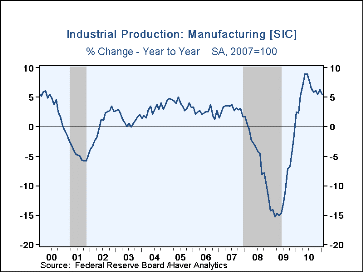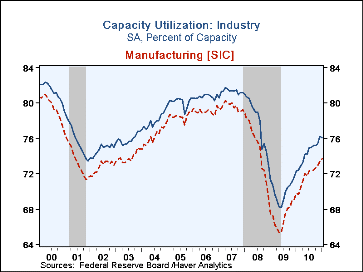 Global| Feb 16 2011
Global| Feb 16 2011U.S. Industrial Production Falls With Less Utility Output While Factories Produce More
by:Tom Moeller
|in:Economy in Brief
Summary
U.S. industrial production slipped 0.1% in January after an upwardly revised 1.2% December increase, initially reported as 0.8%. The latest decline disappointed Consensus expectations for a 0.5% gain. The January figure followed an [...]
 U.S. industrial production slipped 0.1% in January after an upwardly revised
1.2% December increase, initially reported as 0.8%. The latest decline
disappointed Consensus expectations for a 0.5% gain. The January figure followed
an outsized December increase that was boosted by a 4.1% surge utility output.
The return to more normal temperatures lowered output by 1.5% last month and
caused the decline in overall industrial production.
U.S. industrial production slipped 0.1% in January after an upwardly revised
1.2% December increase, initially reported as 0.8%. The latest decline
disappointed Consensus expectations for a 0.5% gain. The January figure followed
an outsized December increase that was boosted by a 4.1% surge utility output.
The return to more normal temperatures lowered output by 1.5% last month and
caused the decline in overall industrial production.
Factory sector output rose 0.3% after a 0.8% December surge, which was double the initial estimate. Strength in consumer goods evaporated as indicated by the 0.1% January uptick following a 1.1% December surge. The diminution largely reflected a 0.1% downtick in nondurable goods output (+3.5% y/y) that was led by a 1.0% decline in petroleum (+10.8% y/y) production. Output of durable goods rose a steady 0.7% (8.3% y/y) as machinery production jumped 1.3% (16.5% y/y) with the strength in capital spending. Output of computers & electronic component also rose a firm 0.9% (13.1% y/y) though output of electrical equipment fell 1.1% (+4.5% y/y). Furniture output rose 0.4% (6.8% y/y) but textile production fell 0.4% (+2.6% y/y).
Capacity utilization overall held roughly steady at 76.1%, up sharply from the recession low of 68.2%. In manufacturing alone, utilization ran at 73.7%, up from 73.5% in December and up from the recession low of 65.4%.
Industrial production and capacity data are included in Haver's USECON database, with additional detail in the IP database; that database contains index data at more decimal precision and also includes extensive lists of relative importance figures for several breakdowns of production by industry and market group.
| Industrial Production (SA, % Change) | Jan | Dec | Nov | Jan Y/Y | 2010 | 2009 | 2008 |
|---|---|---|---|---|---|---|---|
| Total Output | -0.1 | 1.2 | 0.3 | 5.1 | 5.7 | -9.3 | -3.3 |
| Manufacturing | 0.3 | 0.8 | 0.3 | 5.5 | 6.1 | -11.1 | -4.5 |
| Consumer Goods | 0.1 | 1.1 | -0.2 | 2.2 | 4.6 | -5.8 | -4.2 |
| Business Equipment | 0.9 | 1.0 | 0.4 | 11.4 | 7.8 | -12.2 | -1.5 |
| Construction Supplies | -0.1 | -0.1 | 1.3 | 7.2 | 4.0 | -16.7 | -9.5 |
| Materials | -0.3 | 1.5 | 0.4 | 6.3 | 7.0 | -9.7 | -2.7 |
| Utilities | -1.5 | 4.1 | 2.0 | 0.1 | 3.4 | -2.6 | -0.1 |
| Capacity Utilization (%) | 76.1 | 76.2 | 75.4 | 72.3 | 74.3 | 70.0 | 77.9 |
| Manufacturing | 73.7 | 73.5 | 72.9 | 69.8 | 71.7 | 67.2 | 75.0 |
Tom Moeller
AuthorMore in Author Profile »Prior to joining Haver Analytics in 2000, Mr. Moeller worked as the Economist at Chancellor Capital Management from 1985 to 1999. There, he developed comprehensive economic forecasts and interpreted economic data for equity and fixed income portfolio managers. Also at Chancellor, Mr. Moeller worked as an equity analyst and was responsible for researching and rating companies in the economically sensitive automobile and housing industries for investment in Chancellor’s equity portfolio. Prior to joining Chancellor, Mr. Moeller was an Economist at Citibank from 1979 to 1984. He also analyzed pricing behavior in the metals industry for the Council on Wage and Price Stability in Washington, D.C. In 1999, Mr. Moeller received the award for most accurate forecast from the Forecasters' Club of New York. From 1990 to 1992 he was President of the New York Association for Business Economists. Mr. Moeller earned an M.B.A. in Finance from Fordham University, where he graduated in 1987. He holds a Bachelor of Arts in Economics from George Washington University.








